Anteaters and Highways - researching the scale of the problem
09/12/2017 in Conservation
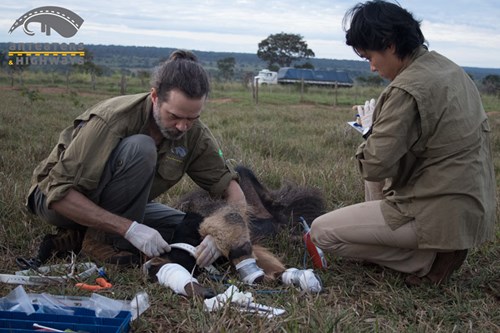
Above: Arnaud and the team attaching a collar to a giant anteater found less than 200m from the highway - Credit Christoffer Bangsgaard
Greetings from Brazil!
Following my update on our Giant Armadillo work last month, I wanted to send you an overview of all the recent events with our other main initiative, the Anteaters and Highways Project. Following our expeditions in the last few months, we are excited to announce that one of the female giant anteaters gave birth. This female, called Bumpus in honor of Renee Bumpus, lives about 3 km from the highway. Our behavior monitoring suggests that she has never crossed the highway, so she and her baby should be safe. Five of our research animals, however, are crossing the highway frequently, which is a major cause for concern. The animated GIF below illustrates the movements of one of the male giant anteaters. Because the base image is from 2013 (and the highway was only paved in 2014) the highway is a stretch of dirt on the image. Make no mistake it is now a new paved highway with high-speed trucks rushing by.
Below: Animated gif showing the movement of a male giant anteaters around its territory, and in this case repeatedly crossing the highway.
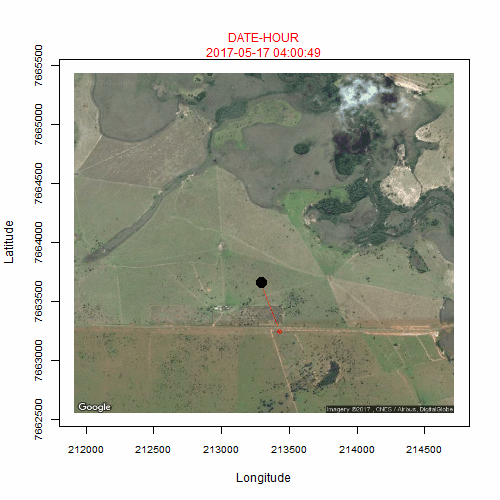
Mario Alvez and Debora Yougi continue their surveys of highways with volunteer and students, surveying 24,353 km of highways since January. Their findings make grim reading. During this time they have registered 1860 animal carcasses, comprised of 239 six banded armadillos, 191 giant anteater, 118 Southern Tamandua, 64 nine banded armadillos 9 southern naked and 3 giant armadillos. As depressing as these figures are you have to remember that these are only the carcasses we see. What about the animals that were injured? We can only see animals that are dead on the road, not those that have crawled away. Necropsies have been undertaken on the fresh carcasses, with a total of 1942 samples, including everything from hair to organs, sent to over 15 partners for further analysis.
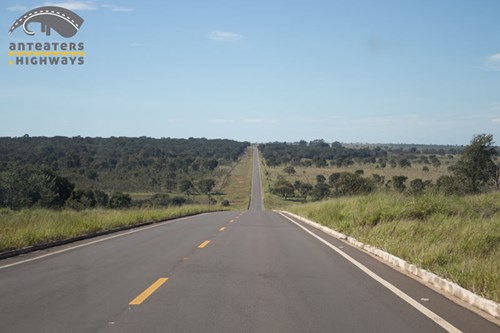
Above: The highway cutting through the landscape - Credit Christoffer Bangsgaard
Below: A Southern tamandua, one of the many other species at risk from increasing traffic on the highway
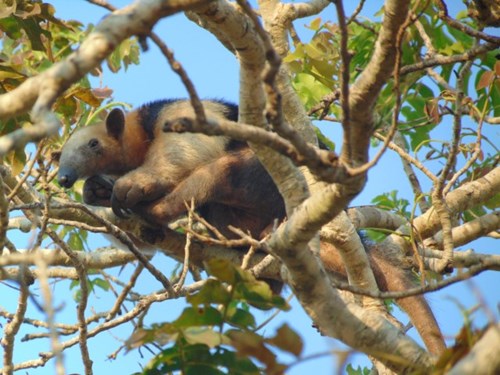
Other research objectives of the Anteaters and Highways Project are also progressing. Ph.D student Mari Catapani has finished her first round of interviews with truck drivers. We are trying understand their perceptions regarding roadkill in particular giant anteaters to develop mitigation strategies. There are many negative superstitions regarding giant anteaters. In October she finished a field expedition where she did 80 interviews. We look forward to sharing these results soon. Vinicius Albereci will also be starting his Ph.D field work with us evaluating impacts of roads using camera traps and occupancy models. Vinicius has been awarded the new Nat Geo Photo Ark Edge fellowship from ZSL to help conduct this work. This is very exciting and will be huge help to the Anteaters and Highways Project. From mid-January to mid-February 2018, Vinicius will attend a four-week Conservation Tools training course in Costa Rica. The course will include a National Geographic Science telling Bootcamp where he will learn from world-class National Geographic photographers, editors and digital video producers. The whole team looks forward to learning from his experience and improving our communication strategies.
Speaking of communicating, thanks to a partnership with United for Literacy, Greenville Zoo and Reid Park Zoo 3 digital children’s books on armadillos are now available. Have a look:
Hotel Armadillo: www.uniteforliteracy.com/aza/wildlife/book?BookId=1409
Giant Armadillo a digging machine: www.uniteforliteracy.com/aza/wildlife/book?BookId=1396
The incredible underground world of the naked tailed armadillo written with the help of the Houston Zoo education department: www.uniteforliteracy.com/aza/wildlife/book?BookId=1413
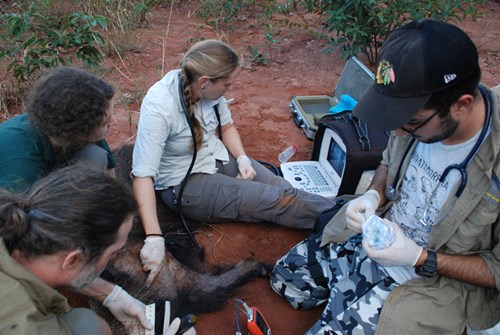
Above: Camilla and the team performing an ultrasound on a giant anteater - Credit Christoffer Bangsgaard
While in Campo Grande we continue to attend meetings and work with our partners. We are involved in a Corridor initiative and are initiating talks for our data to be used in a Cerrado restoration initiative. Bruna has completed her maps and will start now preparing a scientific publication, however we are already using this data to reach our conservation goals. This data on giant armadillos is unique and no other species in the state has this much detailed distribution data. Giant armadillos are being used as a flagship species for biodiversity conservation in the state of Mato Grosso do Sul. A species few people knew about only a few years ago are now influencing habitat conservation measures. We could not be happier.
As always I want to end this update by expressing my gratitude to all of you for making our work possible. The Anteaters and Highways project is not an easy subject matter to research, but being able to prove and quantify the scale of the problem is essential to making people buy into finding a solution. The progress that we have made in raising awareness for the Giant Armadillo, makes me hopefully that we can do so again for the anteater.
Until next time
Arnaud
Featured Articles

An update from the Budongo Forest
19/04/2024 in Conservation

Edinburgh Zoo named best zoo in Scotland
15/04/2024 in Edinburgh Zoo


























Follow EZ